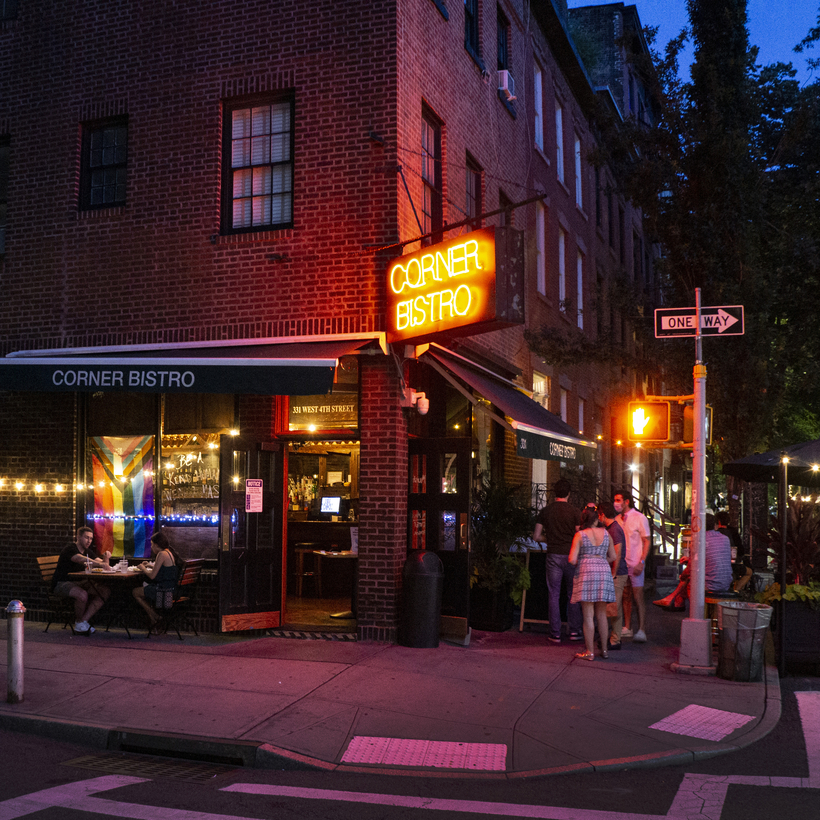Corner Bistro, which has sat in a creaky, centuries-old three-story building on the leafy corner of West Fourth Street and Jane Street, in the West Village, since 1961, has never had the artistic cred of certain other downtown bars.
Unlike the now bulldozed Cedar Tavern, it was not the spot where de Kooning and Pollock crammed into booths during the 50s and 60s and brooded over bottles of cheap Beaujolais, in between posing for Life-magazine shoots. Nor does it possess the literary lineage of its haphazardly gentrified neighbor to the west, the White Horse Tavern (most of whose writerly cachet seems generated by tourists eager to see where Dylan Thomas reportedly drank himself to death).
No, Corner Bistro has always been something more valuable, and increasingly rare, in the Village: it’s a true neighborhood bar, as was made clear one recent afternoon. Soft late-autumn sunlight bounced in through the plate-glass windows while Brenda Lee purred “Danke Schoen” from the house speakers. The aroma of fresh-sizzled bacon, grease, and beer-dampened floorboards filled the room, and the only patrons in the place at three P.M. were two parties of two, sitting at the small tables opposite the bar in the front room.

The first was a father and his eight-year-old son, both munching silently on tater tots and hamburgers and both still wearing their Whitney Museum stickers, having just come from seeing the Edward Hopper retrospective. (Corner Bistro on that afternoon might have been a scene Hopper would have gladly sketched.) At the second table were a mother and her five-year-old daughter, finishing off a grilled cheese and fries.
After a few minutes, the girl, wearing a faded Ghostbusters T-shirt, walked over to the bar and said, “Hi, Billy.” The bartender peered over the bar to see the girl waving her tiny fist, in which she clenched a wad of bills (Corner Bistro is still cash-only). He reached down with his right arm, bearing a large gothic-script tattoo that reads Every day is a gift, and opened his palm. The girl pushed her crumpled bills into Bill’s hand, and as he patted her on the head she told him, “My mom says keep the change.” Her mother smiled at him.
Corner Bistro is that kind of bar.
In a couple of hours the mother and daughter, along with the father and son, would be gone, their quiet tables filled with twenty- and thirtysomethings talking loudly about their lives, while the bar would be three-deep with drinkers calling out orders over the shoulders of some of the stool-roosting elders who are still accorded pride of place.
And so it would go that Friday afternoon, long into the night, with wave upon wave of locals and tourists coming in and going out and coming in and going out, up until four A.M., when the ancient grandfather wall clock in the corner would signal it was, at long last, Time, gentlemen. Time.
Burgers, with a Side of Nostalgia
Corner Bistro holds a special place in the hearts of many New Yorkers. It holds a special place in their stomachs too, thanks to its flame-broiled burgers, which have retained a legendary status across the five boroughs ever since 1978, when the food critic Mimi Sheraton declared them among the best in the city in The New York Times.
Corner Bistro has been in existence since 1961, yet the history of the spot goes as far back as the early 1900s, when the building was home to a rooming house that maintained a small restaurant on the ground floor. After a while, the rooming house folded, and the owners focused on the restaurant and bar.

When Prohibition crashed the party, the family running the restaurant turned the entry room into a butcher shop—as a front for a speakeasy they ran in the back. After Prohibition ended, they sold the spot to a local ward heeler named Barney McNichol, who christened it Barney’s and ran his bar on the site into the 1950s.
The Village was still rough-and-tumble back then, its character defined almost entirely by the bustling docks and piers along the Hudson River only blocks away. It was the era of On the Waterfront, and the camera-ready multi-million-dollar single-family homes that now line the cobblestone streets around the bar were, back then, run-down brownstones that had been chopped up into dingy S.R.O.’s catering to the merchant marines who were continually shipping in and out, often one step ahead of the police.
By the late 50s, Barney’s was no more, and the spot had been bought up by the Frisco brothers, who renamed it Frisco’s and turned it into a bar for gay men. Unfortunately for the brothers, they refused to pay protection money to the Mob—which had dominion over the city’s gay bars—and in short order the N.Y.P.D. Public Morals Squad raided the place and shut them down.
In those days, when a place got busted on a morals clause, the liquor license for the location would be suspended and the premises often boarded up. Three-thirty-one West Fourth Street would likely have suffered a similar fate had it not been for the conniving of a neighborhood writer named Tania Gomez, says the bistro’s manager, Harold Wedick. A jovial man in his 70s with a head of thick gray hair, Wedick started cooking burgers at Corner Bistro in 1967, when he was a junior in high school, and has been there pretty much ever since.
The way Wedick tells it to me over coffee one afternoon, Gomez, looking to make some extra money to supplement her writing life, concocted an idea to turn the shuttered space into a French-style restaurant. She also happened to be friendly with Nelson Rockefeller, who, it seems, soon lifted the morals rap against the building, thus allowing her to acquire a liquor license for the property and open her restaurant, which she named Corner Bistro. To make sure everyone knew it and could find it, Gomez commissioned an orange neon sign for out front.
While the sign survives to this day, her ownership was short lived, Wedick tells me, and by 1967 a man named Bill O’Donnell bought a part ownership that became a full ownership a few years later. O’Donnell kept the name and the one item on the menu that was popular and easy to make—the burger, which is still cooked in what Wedick describes as a “postage-stamp-size” kitchen. The menu has basically remained the same since, with fries, grilled cheese, and chicken sandwiches also served.

A thick-set former army man who once worked as a bellboy on the S.S. America, O’Donnell would sit at the bar each morning counting out the previous night’s cash. He ran the bar until he died, in 2016, and at first, regulars were worried his death would mean the death of Corner Bistro. But there were two things working in the restaurant’s favor. One, O’Donnell had bought the building, which meant that, like a precious few other Village stalwarts, such as Gene’s, on West 11th Street, it could be there as long as it wanted to. And two, O’Donnell’s daughter, Elizabeth, wanted to carry on the business.
I discovered Corner Bistro shortly after I moved to the city, in the late 80s. I was living in a boarding house in the East Village at the time, and one Saturday afternoon in winter I found myself lost in that part of the West Village where the orderly above-14th-Street grid crumbles into a jumble.
Corner Bistro holds a special place in the hearts of many New Yorkers. It holds a special place in their stomachs too, thanks to its burgers, which Mimi Sheraton declared the best in the city.
Looking for a street sign to orient myself, I instead saw Corner Bistro’s neon sign and, peering in through the plate-glass window, observed a place that instantly became like a snug port in a storm. I slid onto a stool by the window and ordered a burger and a beer, and in that small moment I remember that wonderful feeling that maybe, just maybe, I was on my way to becoming a New Yorker. To belonging.
And maybe that was and is the true gift of Corner Bistro—a regular place that is far from regular, because it makes anyone feel like they are a regular. In time, I moved into a studio, just around the corner. I can’t count the number of Saturday afternoons I spent sitting by those windows, reading books, watching the seasons pass. Snow falling on the yellow traffic-light pole. Colored leaves scuttling down Jane Street toward the Hudson.
I remember, too, the night in 1996 when I stood in Corner Bistro, watching that year’s magnificent Yankees as they marched toward their championship. Patrons were shoulder to shoulder that night, and as I stood there glued to the TV, I heard a voice next to me ask, “How did you find this place?”
I turned and saw a man with a gray beard and weather-beaten face. I told him I lived in the neighborhood. He looked at me and was silent for a moment.
“There were so many more of us, back then,” he said.
“More of who?” I asked.
“Old sea dogs. We sailed the world on merchant-marine ships. Back when the river ruled this city, we ruled this neighborhood.”
I nodded. He knocked his mug against mine.
“Bless the Bistro,” he said.
Michael Hainey is a Writer at Large for Air Mail and the author of the memoir After Visiting Friends: A Son’s Story


